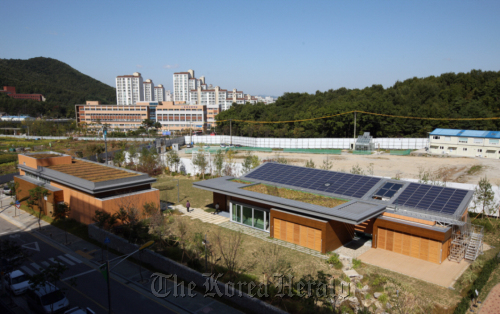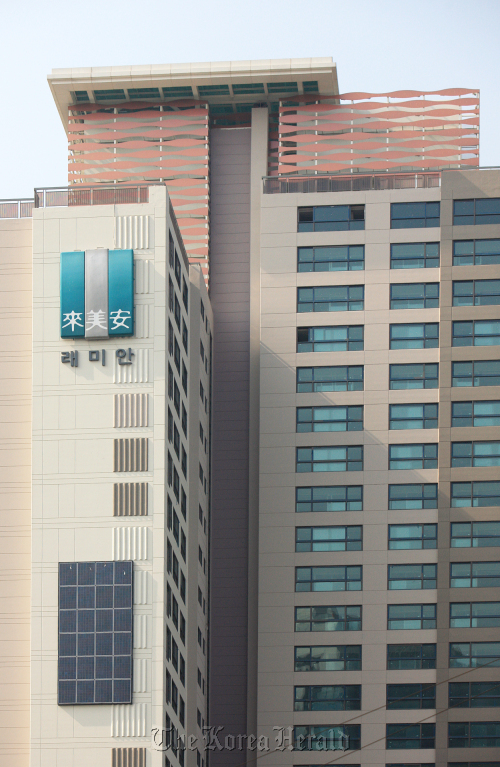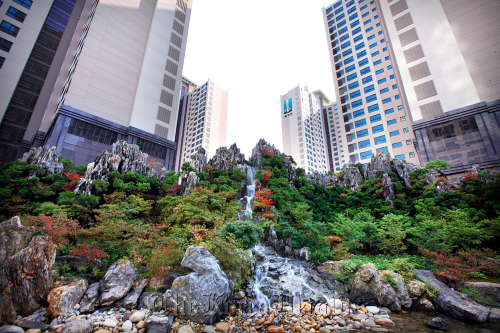Samsung C&T Corp., the country’s No. 2 builder, is strengthening its eco-friendly capabilities to take the lead in applying green technologies to the construction sector.
The company, which developed the zero-energy building Green Tomorrow, has been strengthening research and development efforts, as well as securing a pool of experts. Green Tomorrow contains 68 eco-friendly technologies, allowing the building to cut energy use and use renewable energy sources. The building was awarded the top Platinum rating in the Leadership in Energy and Environmental Design certification.
 |
Green Tomorrow eco-friendly model house in Yongin, Gyeonggi Province. (Samsung C&T) |
“With our Technology R&D Center taking the lead, the company has been establishing a collaborative network with other research organizations to develop and apply diverse eco-friendly technologies,” a Samsung C&T official said.
“Along with conducting research to use renewable energy sources to replace fossil fuels, the company has secured the technologies and capabilities required to apply and maintain wind, solar and other alternative energy systems to buildings.”
In addition to in-house efforts, the company has been collaborating with local and overseas organizations to become more eco-friendly.
Overseas institutions Samsung C&T is collaborating with include Canada Design Research Network in the field of eco-friendly design, Finland’s VTT Technical Research Center in air quality and the U.K.-based Energy Systems Research Unit in energy simulations.
Samsung C&T’s efforts are not limited to boundaries of research, and the results of the company’s extensive R&D programs have been applied in some of the company’s latest projects.
According to the company, simulations carried out in collaboration with the Energy Systems Research Unit played an essential role in applying the Building Energy Management System to a number of buildings including Samsung C&T’s office in southern Seoul.
The company has also applied a range of eco-friendly technologies to its apartment brand Raemian.
 |
A Samsung Raemian apartment building with solar panels fixed to the outer wall |
 |
Samsung Raemian apartment complex in Banpo, southern Seoul |
The Raemian apartment complex in Daegu was the first of its kind in the country to be built with hot-water supply and temperature control system using ground heat, which according to the company is maintained at around 15 degrees Celsius around the year.
“By applying the system to communal facilities in the complex, carbon dioxide emissions were cut by 17 metric tons on an annual basis, while maintenance costs were reduced by 4 million won ($3,700),” a Samsung C&T official said.
The company is also applying similar systems to other Raemian complexes under construction, along with a geothermal system for melting ice on the roads within the complex.
Overall, the company expects the geothermal systems applied at 15 sites will cut carbon dioxide emissions by 5,588 tons, and result in saving 1,833 ton of oil equivalent in energy consumption.
Solar energy also plays a big role in cutting energy consumption at projects built by Samsung C&T.
Energy required to power communal facilities and streetlamps within a Raemian complex in southern Seoul is generated using solar power. In addition, the national sports team’s training complex scheduled for completion this year will be build with a hot water supply system powered by solar energy, while a 72-story compound under construction in Seoul’s Yeouido will include solar power generation and solar water heating systems.
In addition to solar power, the company is also currently testing small wind turbines that will be fitted on ventilation fans for underground parking lots.
With concerns for water resources rising, Samsung C&T has also developed various systems to conserve water.
“Samsung C&T fitted systems to allow rain water to be used for construction, cleaning and gardening and for supplying toilets at 18 construction sites,” a Samsung C&T official said. The official added that three projects will be built with rain water systems with a combined capacity of nearly 5,000 tons.
“The company has also been active in installing greywater systems, and is currently installing the system at 11 sites. In particular, the Samsung Group office in Seoul is fitted with a greywater system with 490 ton capacity.”
Greywater refers to used water that can be recycled.
The company has also developed a high-efficiency greywater treatment system that requires less space and operating costs.
According to the company the new system requires 50 percent less space for installation and requires 400 won or less to treat 1 ton of water.
The company also uses high-efficiency equipment and materials on its projects to help cut energy needs.
By using high-efficiency water pumps and water heaters among other equipment at Raemian complexes, the company estimates that up to 2 billion won has been saved over the past three to five years.
Other energy-saving features Samsung C&T introduced include a two-layer curtain wall.
By building a curtain wall, the effects of the external environment on the building’s interior temperature are minimized.
In addition, the company applied the Air Barrier System, which reduces energy required for air conditioning by creating a layer of air behind a building’s outer wall.
By Choi He-suk (
cheesuk@heraldcorp.com)









![[Robert Fouser] Accepting migrants in South Korea](http://res.heraldm.com/phpwas/restmb_idxmake.php?idx=644&simg=/content/image/2024/10/31/20241031050896_0.jpg)
